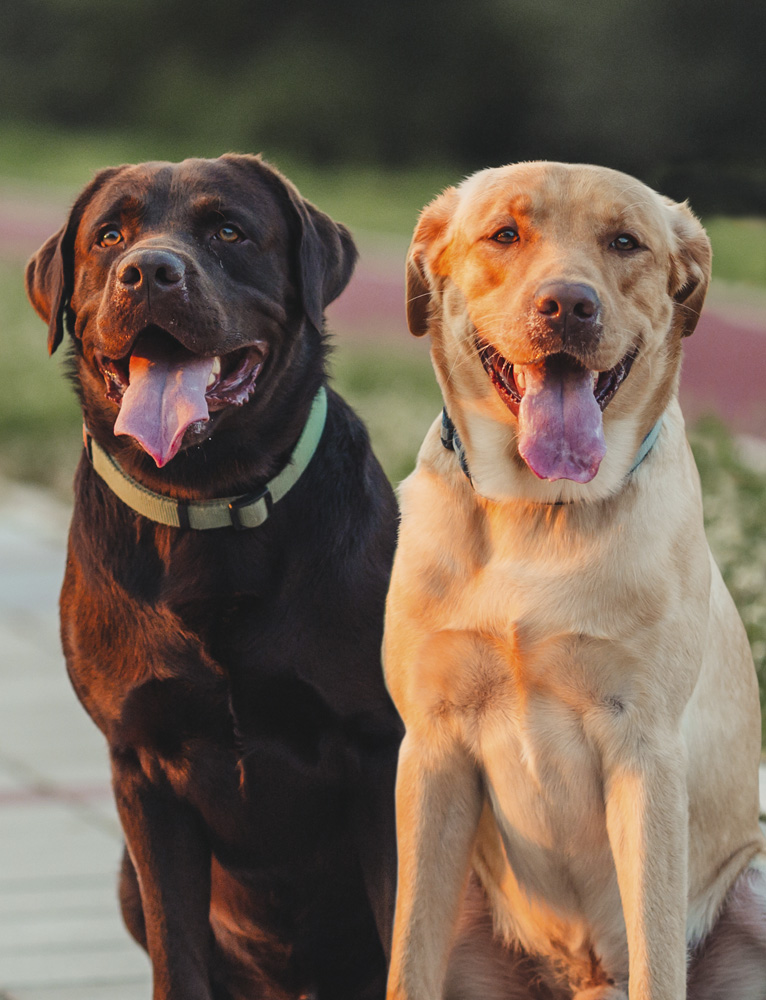Coat-Color DNA Test
DNA testing for coat-color genotypes
Order Dog DNA Tests by Breed
In our state-of-the-art laboratory, we perform dozens of validated DNA tests for hundreds of breeds: Type in your dog’s breed and hit "Search" to see the possibilities. For dogs of unknown descent, type “mixed breed."

Test Highlights:
Name: Coat-color DNA Test
DNA Samples: Collected at Home Using Cheek Swabs
Cost: £58 + S&H per Dog
Results: 5 Business Days after Receipt of Samples
How do I Know if my Dog Carries Genetic Mutations for Coat Color?
DDC Veterinary offers DNA testing for coat color genotypes for several dog breeds. By identifying the color genotype of the parents, our clients can more accurately predict the colors of future offspring. Breeders can use DNA testing as a tool to more effectively manage mating patterns and make more informed selection decisions.
DNA results are emailed within 5 business days, once all samples are received at the laboratory.
Not sure if you need this test? Type your breed into the box above or contact us for a free consultation.
Your Coat Color (EIC) DNA-test kit includes:
- Sterile DNA-collection swabs
- Complete instructions
Coat Color DNA Testing options include:
E Locus (DNA marker tested – R306ter)
Most often used to determine the relationship of the Black (dominant) to Yellow (recessive). The ee genotype results in a yellow phenotype. (“Yellow” can represent a variety of lighter colors including apricots, reds, creams, and whites)
Possible Genotypes:
- EE– does not carry yellow
- Ee– yellow carrier
- ee– yellow phenotype
B Locus (DNA markers tested – S41C, 345delP, Q331X)
Associated with the presence of chocolate (also commonly referred to as liver or brown). The bb genotype usually results in a chocolate coat phenotype and liver noses among yellow dogs.
Possible Genotypes:
- BB– does not carry brown
- Bb– brown carrier
- Bb2– brown carrier
- bb– brown phenotype
For example, with Labrador Retrievers there are three (3) accepted coat color phenotypes (what you can see): Black, Yellow, and Chocolate. However, there are nine (9) possible reported genotypes (what you cannot see) for the E and B loci and therefore 81 possible breeding combinations.
- Black Coat:4 possible genotypes- EEBB (black with no hidden colors), EeBB (black with hidden yellow), EEBb (black with hidden chocolate), EeBb (black with hidden yellow and chocolate)
- Yellow Coat: 3 possible genotypes- eeBB(yellow with hidden black), eeBb (yellow with hidden black and chocolate), eebb (yellow with hidden chocolate- dogs will exhibit liver noses)
- Chocolate Coat:2 possible genotypes- EEbb (chocolate with no hidden colors), Eebb(chocolate with hidden yellow)
Click here to view our Coat Color Predictor Chart. (Requires the free Adobe Reader to view.)
D Locus (DNA marker tested – C.22G>A)
Associated with the dilution or lightening effect of solid colors, with D being the dominant allele, the dd genotype results in the diluted effect (like grey, blue, silver, lilac, champagne).
Possible Genotypes:
- DD– does not carry dilute
- Dd– dilute carrier
- dd– dilute phenotype
Em Locus (DNA marker tested – M264V)
This allele allows the agouti protein to bind some of the time and cause fawn/red pigment to be made on the body and the melanocyte stimulating hormone to bind on the face instead. Dogs that are black, brown or blue do not show their mask against their similar body color. The mask is inherited as a dominant trait.
Possible Genotypes:
- EmEm– the dog is masked and has 2 copies of the dominant allele
- EmEx– the dog is masked & has 1 dominant allele & 1 recessive allele
- ExEx– the dog does not have a mask & has 2 recessive alleles
H locus (DNA marker tested – PSMB7:c.146T>G) Harlequin
Merle-colored Great Danes have dark spots on a diluted/grey background. The Harlequin gene causes a white background and the spots increase in size. Dogs that are not merle, cannot express the Harlequin color/pattern. Breeding two dogs that both have a copy of the H locus “NH” is not recommended. A dog with two copies of Harlequin has not been observed and It is presumed to be lethal in utero. This gene is inherited as a dominant trait.
Possible Genotypes:
- NN– 2 copies of the non-harlequin allele
- NH–1 copy of the non-harlequin allele & 1 copy of the harlequin allele, harlequin is expressed if merle gene is also present
- HH– 2 copies of the harlequin allele, lethal in utero
S Locus (DNA marker – MITF reference: Schmutz S, TG Berryere and DL Dreger. MITF and white spotting in dogs: a population study. Journal of Heredity 2009, 100(Supl 1):S66-S74.)
This allele is associated with Piebald, Parti, Landseer or Random White Spotting among several breeds where these patterns are observed. The inheritance and expression can vary depending on the breed. For example, the gene is most often recessive in nature, however in some breeds such as Collie, Great Dane, Italian Greyhound, Shetland Sheepdog, Boxer, and Bull Terrier, an animal having 1 copy of the piebald allele can exhibit some limited piebald expression.
Possible Genotypes:
NN – 2 copies of the non-piebald allele
N/S – 1 copy of the non-piebald allele and 1 copy of the piebald allele
S/S – 2 copies of the piebald allele
KB Locus (DNA marker – G23del)
The KB is responsible for allowing solid colors to be expressed in the dominant form of the allele (KB). In it’s homozygous recessive form (ky) allows the agouti (a, ay, at loci) colors to be expressed.
Possible Genotypes:
KBKB – 2 copies of the dominant allele – cannot express agouti colors
KBky – 1 copy of the dominant allele and 1 recessive allele – cannot express agouti colors, but can pass the recessive K to offspring
kyky – 2 copies of the recessive allele – can express agouti colors, unless masked by another gene
ay Locus (DNA marker tested – A82S)
This agouti allele is responsible for fawn in breeds like the Pug or sable in breeds like the Collie.
Possible Genotypes:
- ayay– 2 copies of the fawn/sable allele
- ayaw– 1 fawn/sable allele and 1 non- fawn/sable allele
- awaw– 2 non-fawn/sable alleles
a Locus (DNA marker – R96C)
This agouti allele is responsible for recessive black. In the homozygous form aa, it will cause a recessive form of black coat in breeds like the German Shepherd Dog.
Possible Genotypes:
aa – 2 copies of the recessive black allele
aax – 1 copy of recessive black allele and 1 copy of the non-recessive black allele
axax – 2 copies of the non-recessive black allele
at Locus (DNA marker – ASIP reference: Schmutz S and DL Dreger. A SINE Insertion Causes the Black-and-Tan and Saddle Tan Phenotypes in Domestic Dogs. Journal of Heredity 2011, 102(S1):S11-S18.)
This color allele is associated with generating the commonly known phenotypes known as “tan points”, “phantom” and “tri-color” among several breeds. The inheritance and expression can vary depending on the breed.
Possible Genotypes:
awaw – 2 copies of the non-tan point allele
awat – 1 copy of the non-tan point allele and 1 copy of the tan point allele
atat – 2 copies of the tan point allele
Reach Us
Do you have questions or need assistance? Contact our team.
Our Pets & Vets products are serviced exclusively by our U.S.A office. Email your request using the form, and one of our experts will reply as soon as possible.
DNA Technology Park
1 DDC Way
Fairfield, OH 45014
Leave A Message
